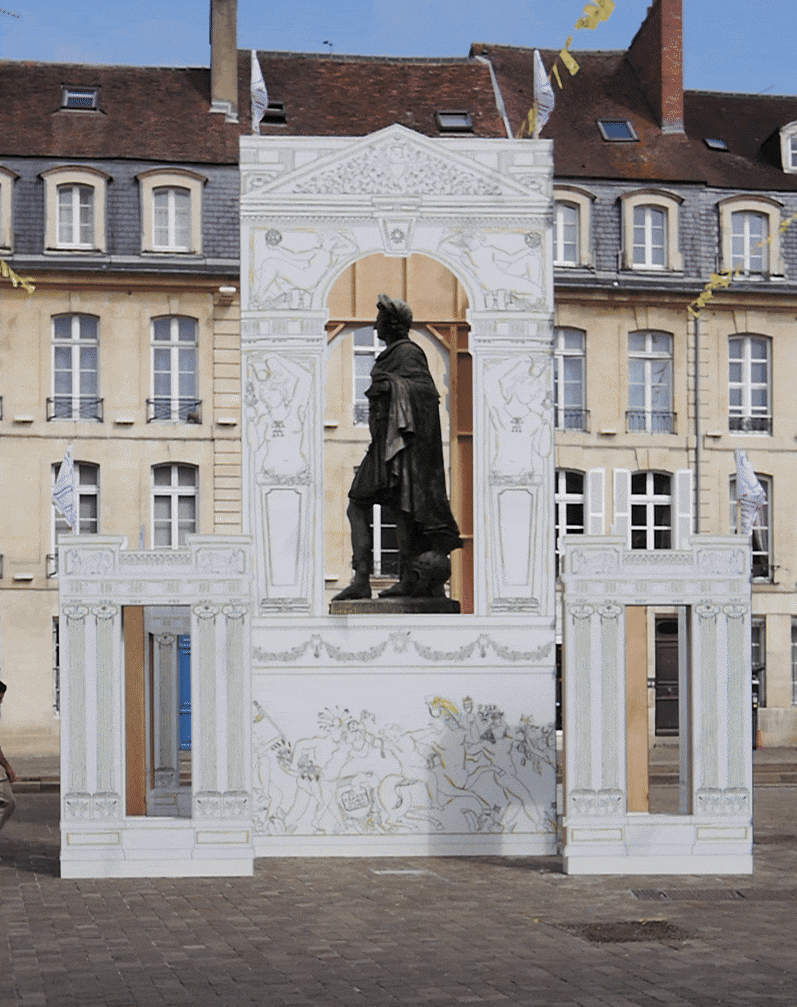_____
Sol Invictus
an altar to pray for the Sun’s mercy
In Caen, the city of William the Conqueror, Guillaume designed a 8m altar to beg for the Sun’s mercy, in the midst of the climate crisis. The art instalation, Sol Invictus, is situated on one of the oldest square of Caen, the Place Saint Sauveur and around a statue of Louis the XIVth. Sol Invictus, the invicible Sun in latin, is part of the “millénaire de Caen” a celebration to marks the thousandth aniversary of the City. Alongside37 artists, including Oliafur Eliason and Françoise Petrovitch, Guillaume’s art installation will be showcased all summer long. Sol Invictus will join the collection of the Musée des Beaux arts de Caen.
Sol Invictus is embedded within the city, a new public space
Long captivated by history and its overlooked corners, Guillaume Sardin draws inspiration from a statue well known to the people of Caen - Louis XIV depicted as a Roman emperor. Through a contemporary and symbolic lens, he presents an epic work that brings architectural follies - those whimsical and festive pavilions - into dialogue with today’s public space. He has created an architecture that speaks through every symbol and figure: from Platonic elements to gods from across the world, spanning from Mesopotamia to South America. Inspired by landmarks from Antiquity, such as the Ara Pacis or the Pergamon altar, Sol Invictus allow passer-bys to sit and stop in the middle of the city.
The triumphal arch (an eight-meter-tall wooden structure adorned with hand-drawn illustrations) creates a bridge between past and present. The Sun King becomes the center of a Creole and animist altar, invoking the mercy of Nature in a world facing climate disruption. An ode to the poetic of relations theorized by Edouard Glissant, “ Each of us needs the memory of the other—not out of compassion or charity, but as part of a new clarity born from the process of Relation” , Guillaume merges together symbols and spirits from across time and space.
Guillaume created a talkative installation, using shared typologies from the classical architecture and references from all across the world . A popular form for a hermeneutic discourse. Each symbol contributes to the larger narration, the tower and apples are symbols of Caen, Sun symbols from Versailles reference Louis the XIVth and platonician elements . The statue is flanked by cariatids supporting the architecture. The cariatids depicts Sumeriand and Egyptian gods. The altar is a representation of a cosmos.
Neith, Egyptian goddess of heatwaves been carried by cult members
The frieze at the bottom of the altar is a large parade led by the solar chariot and Neith, the Egyptian goddess of heatwave. Solar and Nature deities joined the procession, you can find Celtic and Nubian gods, Maya and First Australians spirits. The Solar procession is joyful, yet at the same time a warning, when looking closely latin phrases calls out to us ( Sic transit gloria mundi - “thus passes the glory of the world” , Surgite ! - “rise up !”). The parade ends on a dead Pachamama, the mother goddess, carried by the god of death.
Erected in the very heart of the city, this installation transforms the square into a living stage—open to everyone—where history and imagination meet. Four pavilions placed around the statue will also serve as benches, inviting the people of Caen to sit, share a moment, and contemplate the monument. The artwork will be on view from June 21 to September 21, 2025.
SOL INVICTUS, by Guillaume Sardin for the Millénaire de Caen, collection du Musée des beaux arts de Caen.
art direction : Mathias Courtet
technical team : Ingé Infra








